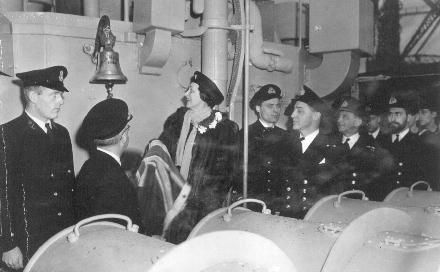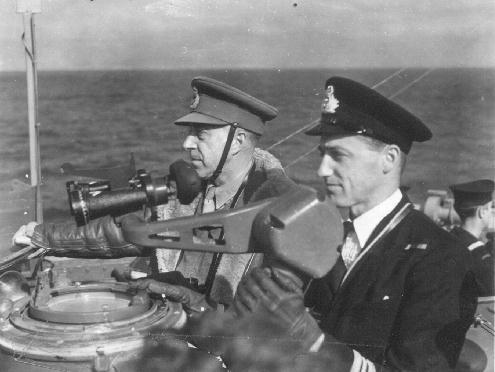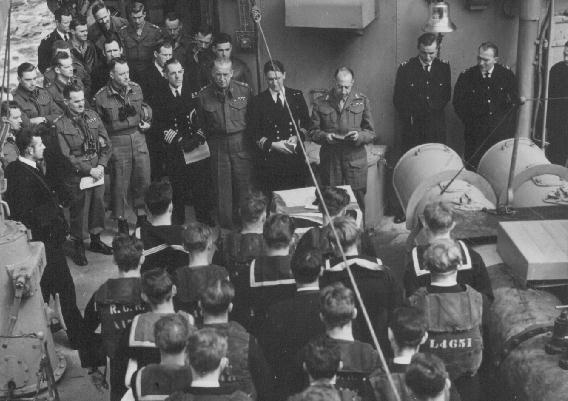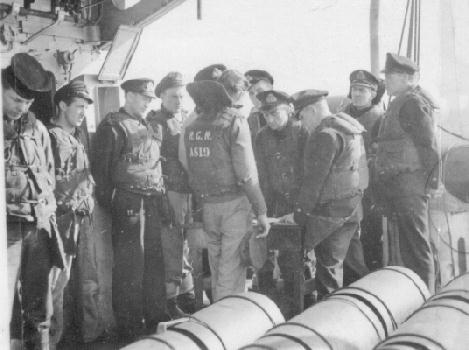![]()
![]()
Many of the photos displayed throughout this web page were taken by Ken Garrett using nothing more than a Kodak Brownie camera. The officers were good enough to look the other way as it was forbidden to own a camera. Some photos, (not identified at this time) were taken by News World. All photos courtesy of Ken Garrett unless indicated otherwise).
 |
No day in the life of a ship is as important as commissioning day. Here, Lady Beaverbrook is inspecting Algonquin on 7th February 1944 after the commissioning ceremonies.How Did Canada Acquire The Ship? - The Quebec Conference was held in Quebec City, Quebec in 1943. Presiding, were Prime Minister McKenzie King, President Roosevelt and Winston Churchill. The purpose of the meeting was to plan strategy that would lead to the end of World War II. Winston Churchill offered to two brand new 'V' class destroyers to Canada as part of the initiative. HMS Valentine's name was changed to HMCS Algonquin, and HMS Vixen became HMCS Sioux.
Lt. Commander Piers addresses his men on the eve of the D-Day invasion. " I have just received a message from Captain "D". Tomorrow is D-Day! There will be no leave from now until the action is over. We cannot take a chance on anyone passing information to their girlfriends or wives which might end up in enemy hands. We have been chosen to be in the spearhead of the invasion, (the crew lets out a sigh ...) I have something to add to this. HMCS Algonquin will be the point on the end of the spear."
All of a sudden the men felt a little sick; they experienced butterflies in their stomachs in the knowledge that tomorrow, many of them might be dead. Quickly, the Captain bellowed out "we will be very close to the beach and if we get hit we will drive the ship up onto the beach and fire our guns to the last shell." All of a sudden, the butterflies were gone and the crew gained the confidence that they could win. Once the invasion began, the Germans fired a few shells at HMCS Algonquin but they all missed. To the crew's surprise, the German gunners then raised their weapons to shoot at a easier target behind the destroyer. That made the crew feel that their ship was the luckiest place to be in that moment of time. (Photo by Jack Misener).
 |
On June 18th, 1944 H.M.C.S. ALGONQUIN returned to the assault area in Normandy, as part of the escort for the Battleship H.M.S. RODNEY. Aboard, as passengers, were the Commander of the First Canadian Army, Lieut.General H.D.G. Crerar, C.B., D.S.O., and his staff. The occasion was looked upon as historic - the first time a Canadian Army Commander had proceeded to enemy territory in a Canadian warship. The General was accompanied by 22 Staff Officers and several Army Press representatives. Here Captain Piers and General Crerar keep a sharp lookout on Algonquin's bridge while enroute to France.
General Crerar always loved a good joke. Here, "Yogi" Jenson, Algonquin's X.O. (left) seems to be coming out with a dandy. (Photo courtesy Clifford Brown)
 |
Algonquin's torpedo and electrical ratings are being inspected by Rear-Admiral Nelles of the RCN and Lt. Cdr. Desmond Piers on 31st March, 1944. Later, the Admiral made a speech in which he expected the crew to do great things to end the war and that Algonquin was a key to end the war of all wars.
 |
This was Sunday Divisions with Lieut.General H.D.G. Crerer giving a lesson from the bible while Algonquin was enroute to France, 10 days after 'D' Day. He was a good general and proved to be the right man to lead Canadian troops in Europe.
 |
Sunday Divisions as seen from the Bofors platform on Algonquin.
 |
There's no day like pay day! Scenes like this were typical on RCN ships and Algonquin's crew was no different in the eagerness to receive their pay.
|
|